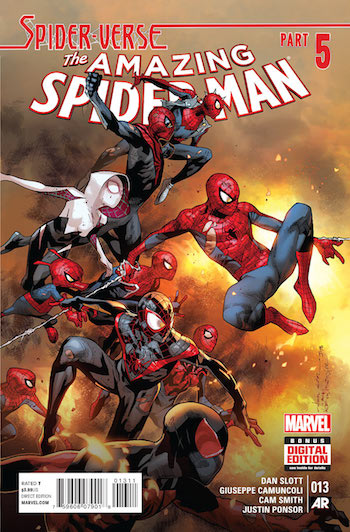Thursday Comics Hangover: Let’s sell some action figures!
Every comics fan knows Wednesday is new comics day, the glorious time of the week when brand-new comics arrive at shops around the country. Thursday Comics Hangover is a weekly column reviewing some of the new books that I pick up at Phoenix Comics and Games, my friendly neighborhood comic book store.
For many years, the publishers of superhero comics tried to convince their readers that it was the characters that mattered most, not the creative teams behind the characters. But that’s obviously not true; the writing and the art is what makes a real impact. This is why G. Willow Wilson’s Hugo-winning series Ms. Marvel, for example, has become a runaway bestseller for Marvel Comics — shape-changing characters and teenaged superheroes are plentiful in comics, but Kamala Khan is as unique and as iconic as Peter Parker. Without Wilson’s voice, the book would have already come and gone, yet another doomed attempt at brand maintenance, another new superhero tossed onto the pile of misfit intellectual properties.
But despite a handful of strong writing voices — Wilson’s Ms. Marvel, Nick Spencer’s Superior Foes of Spider-Man and Ant-Man, Cameron Stewart’s Batgirl, Ryan North’s Squirrel Girl — it’s a bad time for mainstream superhero comics. The major publishers have fallen back on what I’ve always thought of as the business of action figure manufacturing: the stories invariably get the heroes into as many new costumes as possible so they can sell the action figures to fans six months later. It all reeks of bad fan-fiction.

Consider Spider-Verse, a crossover that pitted hundreds of Spider-Men from parallel dimensions against some cross-dimensional force that wanted to kill every Spider-Man in the quantum universe. It’s hard to imagine anyone but the most ardent Spider-Man fans picking up this story, mired as it is in decades of noodling continuity; the Wikipedia page for Spider-Verse is as impenetrable as some tax codes. (I don’t mean here to pick on Spider-Man author Dan Slott, as his Silver Surfer comic with Mike Allred has been one of the most refreshing surprises of the last year, especially the recent issue that was formatted like a neverending Möbius strip that required the reader to turn the comic upside down and right-side up in a figure eight to follow the story.) And as much as I’ve enjoyed the world-building of Jonathan Hickman and Esad Ribic’s Secret Wars — it’s as close to a Game of Thrones that a superhero comic will ever achieve — even the most recent issue, #5, is starting to strain against the premise. How many multiple versions of heroes can we read about before they lose everything that made them special to begin with?
Something about superhero comics, if you let them run on long enough, eventually turns the story inward, and the struggle always becomes about the hero versus herself. Think of the Superman comics of the 1960s and 70s, in which Superman rarely battled an external threat. Usually, he’d struggle with some facet of his own personality — the imperfect duplicate Bizarro, a chunk of Red Kryptonite that would turn Superman evil, a Kryptonian who lacks Superman’s morals and so tries to take over the world — or deal with some sort of trickery from supporting cast members like Lois Lane or Jimmy Olsen. Eventually, the books took on a weird psychoanalytic air as Superman would divide himself into two and try to solve all the world’s problems, say, or spend entire issues exploring alternate timelines in which Krypton never exploded or in which he married Lois Lane.
As much as I enjoy those Superman comics — along with some old Peanuts collections, these comics are how I learned to read, and I’ve always been fascinated by their jovial weirdness — they almost killed the medium. Around the time that Superman was reaching his most introverted, comics went from a mass medium to a pastime for hobbyists. (Don’t believe me? Check the sales figures yourself; Superman comics went from selling 810,000 copies a month in 1960 to 285,634 copies monthly in 1974.) These impenetrable superhero comics are really just about continuity; they’re stories about the stories that have come before, with so many winks and nods and outright curtsies to the reader that they stop being about anything but the comics themselves. I’d call it postmodernism if it demonstrated an ounce of self-awareness.
Recently, comics gossip site Bleeding Cool announced that DC Comics, coming off its own highly unpopular self-reflexive comics event, has told its editors to turn away from the “quirky, experimental, off the wall and less continuity-laden comic books” they had recently begun to encourage, instead telling them to fall back on the status quo. “Comic book audiences are a lot more conservative than some people give them credit for,” Rich Johnston at Bleeding Cool concludes.
That may be so.
But people who don’t ordinarily read comics aren’t conservative at all, and they’re the ones who can expand the audience for superhero comics beyond the same dwindling crowd of 40-something men who have always read them. The non-superhero-buying-comics crowd are the people who turned Ms. Marvel into a surprise blockbuster, arguably the first superhero character to break into the mainstream consciousness since Wolverine and/or The Punisher debuted, back in 1974. To draw that kind of an audience, you need to put aside the intellectual property management and focus on the singular voice of a creator who knows what she wants to say, and believes in her own ability to say it. Superhero comics creators shouldn’t be in the business of trying to give comics fans what they want; they should be trying to convince everyone else to care about superhero comics.